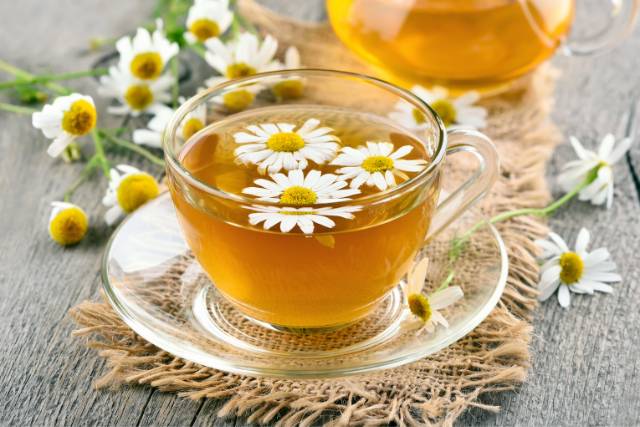Recent Posts
-

- Diabetes-Friendly Nutrition: Smart... 08.12.2024
-

- Nutrition for Chronic... 08.12.2024
-

- Anti-Inflammatory Diet: Food... 08.12.2024
-

- Low-Sodium and Heart-Healthy:... 08.12.2024
-

- Plant-Based Diets for... 08.12.2024
Chamomile and Sleep: Exploring the Relaxing Effects on Insomnia

Amid the rush and bustle of our contemporary life, when stress and obligations often weave a complex tapestry that persists even in the calm of the night, the pursuit of deep sleep becomes a refuge that is sought after. The unassuming herb chamomile has a great secret: the capacity to cradle us into a tranquil embrace, gently easing away the tensions that have been building up throughout the day. Chamomile has earned its reputation as a time-honored partner searching for restful sleep. It is like a calming salve for the tired mind and a soft caress for the restless spirit. Chamomile has earned its reputation.
Chamomile, which has delicate blooms that resemble daisies and a smell reminiscent of apples, goes beyond its aesthetic appeal to provide an herbal medicine firmly anchored in cultural traditions. In addition to its charming look, chamomile has a long history entrenched in ancient treatments. Chamomile has been revered for its relaxing powers to the point that it has become a reliable partner in the rituals associated with slowing down. As we make our way through the relationship between chamomile and sleep, let us explore the peaceful regions of this herbal elixir and disentangle the delicate threads that create a tapestry of tranquility under the lunar canopy of the night.
The chamomile plant is Among the blooming plants classified as members of the Asteraceae family. German chamomile, also known as Matricaria chamomilla or Matricaria recutita, and Roman chamomile, also known as Chamaemelum nobile or Anthemis nobilis, are the two primary varieties of chamomile that are used for their therapeutic benefits. The two types are used for comparable purposes, although their botanical properties are somewhat different.
The chamomile plant is well-known for its beautiful blooms resembling daisies and white petals and a yellow disk in the center of each blossom. The aroma of the flowers is reminiscent of apples and is quite fragrant. Chamomile has been used in traditional medicine for a long time, stretching back thousands of years to ancient civilizations.
Because of its relaxing and soothing effects, chamomile is often used to prepare herbal teas and infusions. It is generally known for these qualities. The common practice of drinking tea is to facilitate relaxation, reduce tension, and facilitate sleep. Additionally, chamomile may be available in various forms, such as essential oils, capsules, and topical lotions, each with its own set of uses.
The benefits of chamomile on insomnia have been a topic of interest for scholars and those passionate about herbal remedies. Chamomile, having soft and calming features, has been connected for a long time with the promotion of relaxation and the improvement of the quality of sleep. When investigating the effects of chamomile on insomnia, there are numerous factors to take into consideration on the following:
Calming Effects:
Chamomile includes chemicals such as apigenin, which have effects that are similar to those of a moderate sedative and anxiolytic (that is, anxiety-reducing). Because these qualities contribute to the herb's capacity to generate a feeling of serenity and relaxation, it has the potential to be therapeutic for those battling insomnia.
Increased sleep quality:
There have been studies that show that chamomile may improve the quality of sleep. Chamomile tea use before going to bed has been linked to improvements in subjective sleep measurements, such as a shorter amount of time required to fall asleep and a higher frequency of awakenings throughout the night.
Reduced levels of stress and anxiety:
The presence of elevated levels of worry and stress is often associated with insomnia. The relaxing properties of chamomile might assist in relieving these conditions, therefore generating an atmosphere favorable to healthy sleep.
De-stressing muscles
There is a widespread belief that chamomile has the potential to relax muscles. It may help an overall sensation of physical comfort by encouraging muscular relaxation, which may benefit persons suffering from tension-related sleeplessness.
Other Herb Combinations:
In some instances, chamomile is coupled with other well-known herbs for their ability to induce sleep, such as lavender or valerian root. Certain combinations will likely have a synergistic impact on the promotion of sleep.
Individual Differences:
It is essential to remember that different people might react differently to chamomile. Some individuals may not experience the same advantages as others, although many find it helpful in enhancing their sleep. In addition to individual sensitivity, the results might be affected by dose, preparation technique, and other factors.
Administrative Form:
In addition to being ingested in tea, chamomile may be taken as capsules or an essential oil. Each form's absorption rates and bioavailability are different, which could affect how successful it is in treating insomnia.
Healthcare Professional Consultation:
Before depending entirely on herbal medicines, those who are having persistent insomnia or sleep difficulties should seek the advice of specialists in the healthcare field. A good sleep habit may benefit from the addition of chamomile. Still, it is essential to treat any underlying health concerns before using chamomile.
In conclusion, the soothing, anxiety-reducing, and muscle-relaxing characteristics of chamomile are why it can cure insomnia. Although research indicates that chamomile benefits the quality of sleep for many people, individual experiences may differ. Therefore, it is best to include chamomile in a holistic approach to improving your sleep hygiene and general well-being.
Disclaimer: The information provided in this article is for general information purposes only. All information in this article is sourced from other websites, and we do not represent any rights regarding the contents and information on the site. All rights belong to their original owner.





